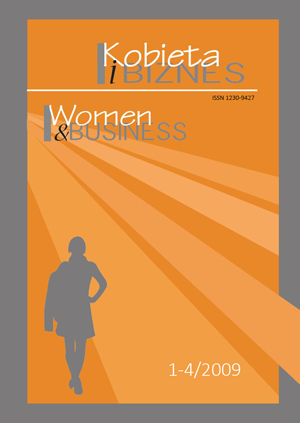Diversity management: key concepts
Main Article Content
Abstract
Managing diversity is usually associated with preventing discrimination. Within the framework of the "repair action" implementation, there is applied assumption concerning the need for equalising chances of persons belonging to minority groups, excluded or deprived of access to different spheres of social life: education, labour market, executing power. In practice it leads to initiating various affirmative actions, or for example to the introduction of the quota system guaranteeing a fixed number of places at schools, universities, in companies, or in parliaments for the members of these groups. However, managing diversity does not only mean granting preferences or equalising chances of individual members of a particular group (although this also happens). Thus, managing diversity comprises taking advantage of diversified experience, knowledge, skills, predispositions, and sensitivity (purely professional, but also cultural) within the entire organization or company. The contents and dynamics of the debate concerning the role of diversity in shaping the quality of social, economic and political life were determined by gender and race. However, they are not the only dimensions of diversity. Currently various other diversity aspect are treated equally, such as: ethnic group, nationality, religion, age, disability, sexual preferences, or the so-called "black sheep", i.e. persons excluded because of their negative branding, for example history of serving prison sentence, alcoholism and addiction to drugs, or persons who had a history of psychiatric treatment. Nevertheless, the approach to the issue of diversity in business companies is not homogeneous. David A. Thomas and Robin J. Ely define three diversity paradigms: assimilation paradigm, variety paradigm, integration paradigm. (fragment of text)
Article Details
Authors retain copyright and grant the journal right of first publication with the work simultaneously licensed under a Creative Commons Attribution License that allows others to share the work with an acknowledgement of the work's authorship and initial publication in this journal. All authors agree for publishing their email adresses, affiliations and short bio statements with their articles during the submission process.
Author agrees to share his work under CC-BY-NC license.
References
2. Aksamit B., Gdzie się pchasz na tym, "Gazeta Wyborcza", 11 stycznia 2008.
3. Helfat C. H., Harris D. i Wolfson P.J., The Pipeline to the Top: Women and Men in the Top Executive Ranks of U.S. Corporations, "The Academy of Management Perspectives", November 2006.
4. Hewlett S. A., Executive Women and The Myth of Having It All, "Harvard Business Review", April 2002.
5. Live Longer, Work Longer, OECD Report, 2006.
6. Merton R. K., Teoria socjologiczna i struktura społeczna, PWN, Warszawa 1982.
7. Transforming Disability into Ability, OECD Report, 2003.
8. The Bottom Line: Connecting Financial Performance and Gender Diversity, Catalyst, 2004, www. catalyst.org
9. The Double-Bind Dilemma for Women In Leadership: Damned if You Do, Doomed if You Don't, Catalyst, 2007. www.catalyst.org
10. Thomas D. A., Diversity as Strategy, "Harvard Business Review", September 2004.
11. Thomas D. A. i Ely R. J., Making Differences Matter, "Harvard Business Review", September-October 1996.
12. When Work Works (2007), Families and Work Institute, www.familiesandwork.org
13. Women in Leadership: A European Business Imperative, Catalyst and The Conference Board, 2002, www.catalyst.org

